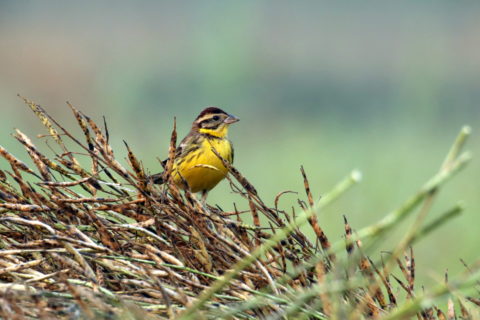Conservation Actions
Conservation and Research Actions UnderwayAmbabok and Dunoy, where the species has been recorded annually since 2003 (M. van Weerd in litt. 2016), is located within the Northern Sierra Madre Natural Park (NSMNP), although there is no active law enforcement in this area. In 2016, the Isabela Oriole was adopted as the flagship species of the NSMNP. The Bataan Natural Park/Subic Bay protected area, which supports up to 50 km2 of forest, probably encompasses one of the historical localities. Exploratory surveys in 2007 of the eastern side of the NSMNP upstream of the Palanan River and along the Pacific coast in Palanan, Divilacan and Maconacon, at 0-1,000 m, failed to find the species (M. van Weerd in litt. 2012). In 2012 and 2013, a new survey project (by students at the University of the Philippines, Isabela State University and the Mabuwaya Foundation) was conducted, with the aim of visiting all historical locations for the species in the Sierra Madre and Bataan, and to survey suitable habitat in San Mariano municipality in the Sierra Madre (M. van Weerd in litt. 2012). The project found the species in five locations and collected basic information on its ecology and habitat requirements (Acay and Realubit 2014). Since 2015 a research and conservation project for the Isabela Oriole is implemented in Baggao by the Mabuwaya Foundation. Information, education and communication campaigns are implemented; community consultations are held in Baggao with the local government, the Department of Environment and Natural Resources and local residents. Plans are underway to declare the oriole site in Baggao a Critical Habitat and to encourage ecotourism. The Isabela Oriole population is monitored quarterly and studies on behaviour, diet and habitat use are ongoing (M. van. Weerd in litt. 2016, 2017). Monitoring is planned to continue, possible new sites will be surveyed and studies will investigate resource competition between oriole species (Acay and Realubit 2014).
Conservation and Research Actions Proposed
Conduct extensive surveys, particularly in bamboo forests, around historical sites in Bataan, the Mariveles Mountains and Mt Cetaceo and other unsurveyed lowland forest sites of the Sierra Madre, and also Diffun (Quirino Province) where it was reported in 1996. Propose key sites found for formal protection. Lobby for active on-the-ground protection of the NSMNP. Continue to raise awareness among local people and local government about the species in an effort to implement conservation measures.
Location Information
Oriolus isabellae is endemic to Luzon in the Philippines (Collar et al. 1999). It is known historically from three localities in Bataan province and five in the north-east of the island. Eleven birds were collected near San Mariano in the Sierra Madre mountains in 11 days in 1961, indicating that it may not have been particularly rare in suitable habitat. However, in the north-east it has been recorded recently at just five localities (in 1996 in Quirino province and Cagayan province, and since 2003 yearly at Ambabok and nearby Dunoy and Diwagden, San Mariano municipality, Isabela province [van Weerd and Hutchinson 2004, M. van Weerd in litt. 2007, 2016, Acay and Realubit 2014]), and since 2012 in Ipil (Gonzaga, Cagayan) and in several sites in the municipality of Baggao, Cagayan (Acay and Realubit 2014). The total known population currently is about 50 individuals, with two sub-populations of 10-20 individuals each in the municipality of Baggao and about 10 individuals in the municipality of San Mariano (M. van Weerd in litt. 2016, 2017). There have been no observations in Bataan since 1947 despite a recent intensive search for the species there (Acay and Realubit 2014) and surveys in northern Cordillera yielded no sightings (Lowney et al. 2015). Surveys in relatively undisturbed forest along the eastern coast of the Sierra Madre and the western frontier of lowland forest in Cagayan Valley since 2006 failed to locate the species outside the above mentioned localities (M. van Weerd in litt. 2016, 2017). This indicates considerable rarity and that its distribution is probably patchy.Geographic Range
Extant
Philippines
Population Information
The currently known populations in the municipalities of San Mariano, Isabela and Baggao, Cagayan have been carefully monitored since 2012. The current population estimate in these two municipalities is 50 mature individuals. The total global population is precautionarily estimated to number fewer than 250 mature individuals, and so it is placed in the band 50-249 mature individuals. This equates to 75-374 individuals in total, rounded here to 70-400 individuals.Threats
It may be a lowland specialist and hence lowland forest destruction is assumed to be its primary threat. Since the 1930s, forest cover in the Sierra Madre has declined by 83% and by the late 1980s only 24% of Luzon was estimated to remain forested, with most remaining areas under logging concession. There is virtually no forest left near Disulap, a key historical site, and one of the recent records was from a degraded forest tract of only 100 km2, isolated from the Sierra Madre forests and offering no long-term prospects for the species. Illegal logging and agricultural encroachment in the western part of the Northern Sierra Madre Natural Park (NSMNP) threatens remaining habitat, and habitat protection and law enforcement are very weak in San Mariano municipality (M. van Weerd in litt. 2012). Competition with the closely related White-lored Oriole (O. albiloris) is likely to impact this species (van Weerd and Hutchinson 2004, Acay and Realubit 2014).Partners
IUCN Red List Account Link
Please click here to see the species' IUCN Red List Account page.Photo Credits
Merlijn van Weerd






